Outdoor Tiki Huts and Bars – A Basic Overview
by William Murphy
Installing a tiki hut or bar in your backyard is a unique way to add fun and tropical vibes to your pool parties and family gatherings. Alternately, if they are portable, they can be used for commercial applications as well such as markets and conventions.
You will see outdoor tikis in a variety of sizes, depending on whether the structure is designed to be strictly a hut (big), or more of a bar (small), whether it’s prefab, or a custom build.
If it is more of a mini bar type of situation, these can be purchased as its own do-it-yourself kit (see our Paradise Tiki Bar Kit below), using a combination of quality synthetic and real materials, and which can be easily be stored away on the off-season.
That said, the larger the structure you have in mind, the more likely it will need to be built from scratch, which is something you can do yourself if you’re handy and have the proper supplies. Otherwise, you’ll have to hire someone to do it, and, like anything else, the costs go up, but then you can leave the actual construction to the pros.
Generally, what we love about outdoor tiki bars is that they bring out a feeling of peace, relaxation, and joy, turning your backyard into a tropical paradise.
| TIKI Brand 25 Inch Stainless Steel Low Smoke Fire Pit |
|---|
| Yiosax Solar-Powered Tiki Statue |
| TIKI Brand 65-Inch Cabos Bronze Metal Torch |
We sometimes think of tiki huts and bars as the more tropical cousins of gazebos. Tiki huts can also be used for creating outdoor theaters (if they’re big enough), simple shade structures for private or public events, as well as outdoor ticket booths and vendor areas.
Actually, tikis can be used in all sorts of situations where a permanent or temporary open-air structure is needed.
Our today’s article is all about these world-famous huts. Here is what we are going to cover today:
- The Interesting History behind Tiki Huts
- What Makes Tiki Huts so Popular?
- What Are the Defining Features of Tiki Huts?
- Different Types of Tiki Huts
- Tiki Accessories (Signage, Accents, etc.)
- Do You Need a Permit to Build a Tiki Hut?
Let’s start with the history behind Tiki Huts…
The Interesting History behind Tiki Huts
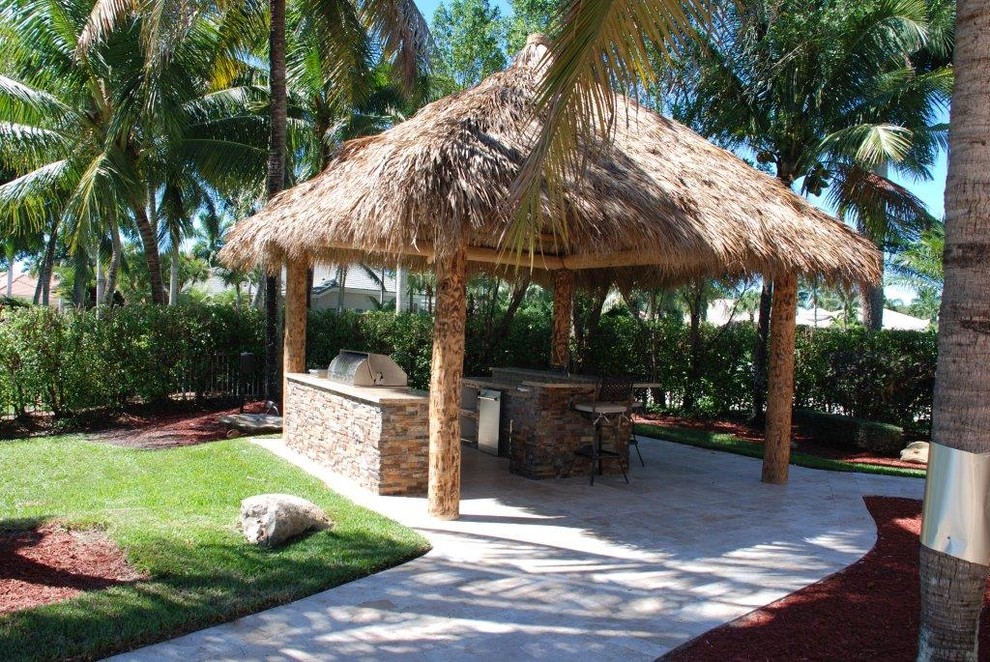
Although many people may believe that tiki huts originated from some remote island culture, they actually originated from the United States of America.
Tiki huts were originally built by the Seminole and Miccosukee tribes of Florida. The beginning of the 19th century was a difficult time for Native Americans. The Seminole and Miccosukee tribes had to move around a lot and they needed a shelter that could be put up and taken down easily.
These tribes eventually fled to the Everglades where they had an unlimited access to cypress logs and palm fronds which they started using for making huts.
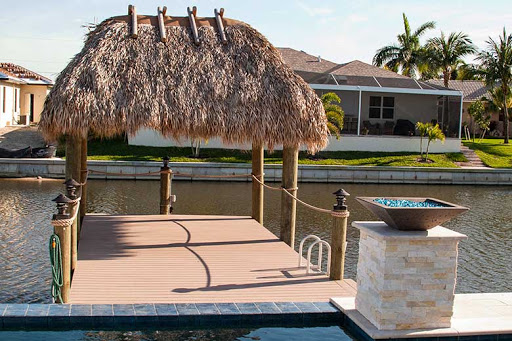
The Seminoles referred to their huts as “chickees,” which is Seminole word for “houses.” The huts were made of a raised platform to prevent the floor from flooding, sturdy cypress posts, and a thatched roof.
In a way, tikis are the warm-weather version of igloos, where people needed to rely on Mother Nature to provide them with the materials to make some sort of sturdy protective dwelling or shelter.
Somewhere throughout their history, the huts began to be referred to as “Tiki Huts”, a reference to the Tiki style of the South Pacific. Tiki huts, as we know them today, are a product of the two cultures.
The name “Tiki” originated from the Polynesian mythical figure of Maori, who was also known as Tiki.

This man, according to Polynesian mythology, was believed to be the first man created by the gods. The name and the origins quickly spread throughout the United States.
Next, we discuss what makes Tiki Huts so popular nowadays…
What makes outdoor Tiki Huts so popular?
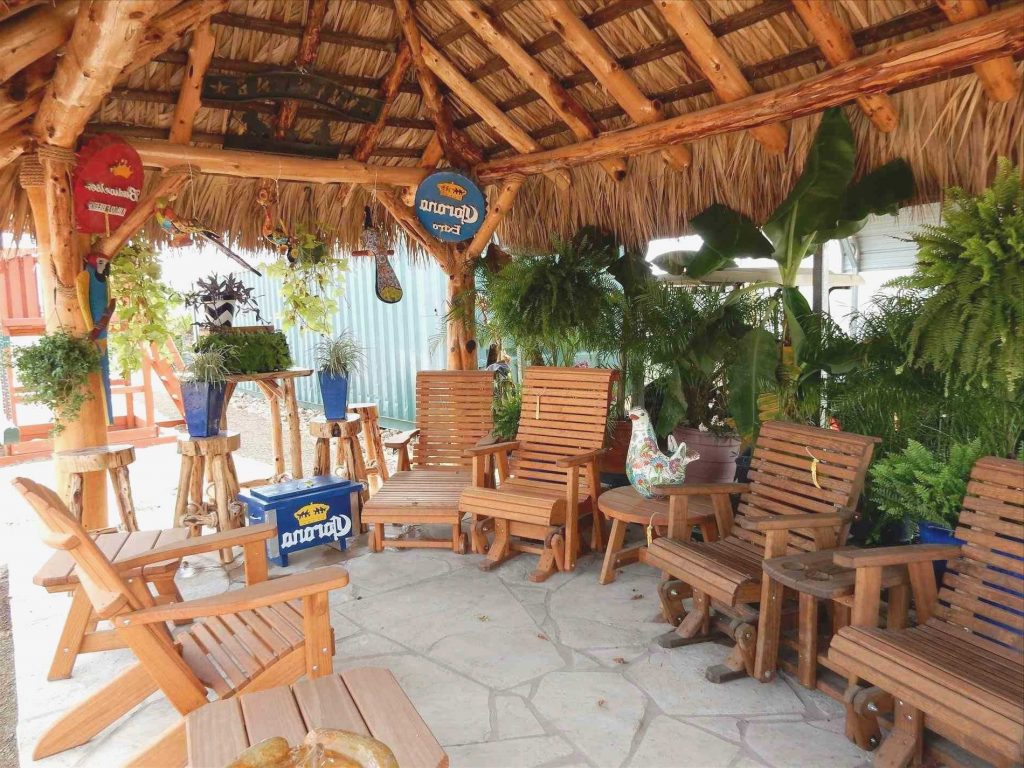
Tiki Huts can bring the fun and excitement of a remote tropical island to your backyard or business. They provide a unique way to relax, rejuvenate and get away from all the stress and problems you might have in your life. You could be living anywhere in the world and still enjoy the comforts of paradise thanks to these amazing huts.
Wherever there are tiki huts, there is a lot of fun to be had. Not many people will be able to refrain from the natural allure of a well-designed tiki hut. This is also why tiki bars exist, because because the materials used in making tikis seem to evoke a fun atmosphere, and for some, there is no more fun social hub than a wooden bar where you can pull up a stool and have a drink!
The unique appearance of tiki huts and bars is more than enough to catch anyone’s attention. Your friends and your family will definitely be amazed by the simplicity and the beauty of your tiki hut.
Tiki huts are also fairly easy to install can be cost effective, depending on where you source your materials, and who is in charge of building it. Actually, due to the rising price of wood these days, and the slowness of shipment of certain materials, you could end spending a lot if you’re not careful – so be on your toes when it comes to pricing out materials. This is, again, why we recommend our Paradise tiki, because the materials are high quality, the structure is portable, and it is made with TLC right here in the USA!
Next, we move on the defining features of tiki huts…
What Are the Defining Features of Tiki Huts?
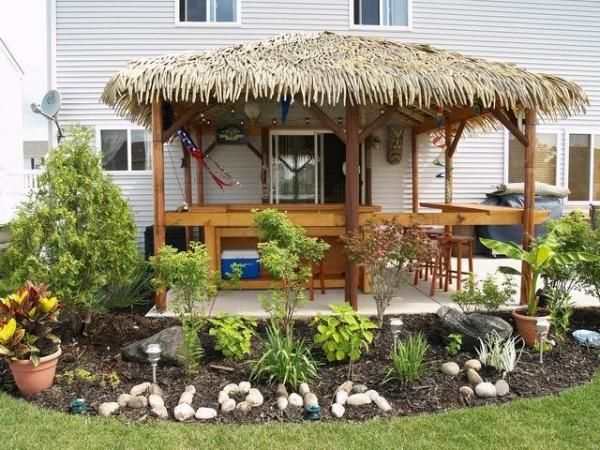
You don’t have to be an architect or builder to easily recognize a tiki hut. These shelters have a very distinctive look so even children can recognize them. They are unique, and you don’t see them every day, but you know one usually the second you see one, due to their thatched roof and warm wooden appearance.
It’s all about that thatched roof! Thatch roofs is what give them their characteristic appearance, as they look tropical, casual, and natural. Tiki thatch roofs move organically in the breeze, unlike any other roofing material. That said, the thatch stays where it is, and doesn’t litter your property. It is actually, for those not familiar with tiki huts, very durable and sustainable!
In fact, a tiki palm thatched roof can even withstand a Florida hurricanes. They can last up to ten years, which is amazing to think about, but isn’t so surprising when you consider that tikis were originally built close to the sea where the wind was whipping them all the time.
A Tiki thatch roof covering is all about ambiance, peace, relaxation and tranquility. However, not all thatch roof for tiki huts are the same. Nowadays, tiki thatching is available in several different colors and styles including Mexican Rain Cape, Tahiti Thatch and Thatch Reed Panels.
Stay with us to find out more about different types of Tiki thatch roof covering…
Different Types of Tiki Huts
Mexican Rain Cape
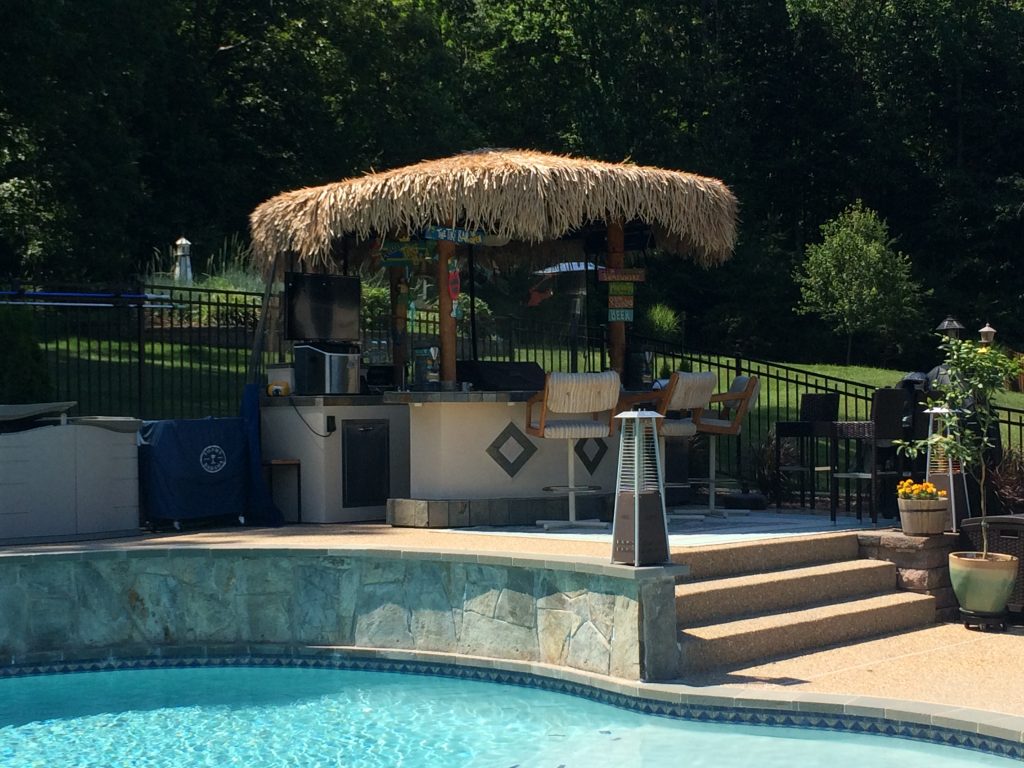
Mexican Rain Cape is made with the fronds of Mexican palm trees and comes in a light blonde color. It is installed in naturalistic, uneven strands around the roofline, which make it look more natural than man-made.
Mexican Rain Cape is one of the most budget-friendly types of thatch which can last indefinitely indoors. However, it does have one drawback. It’s unlikely to last more than 18 months outside.
Here is a great video explaining more about Mexican Rain Cape.
Tahiti Thatch
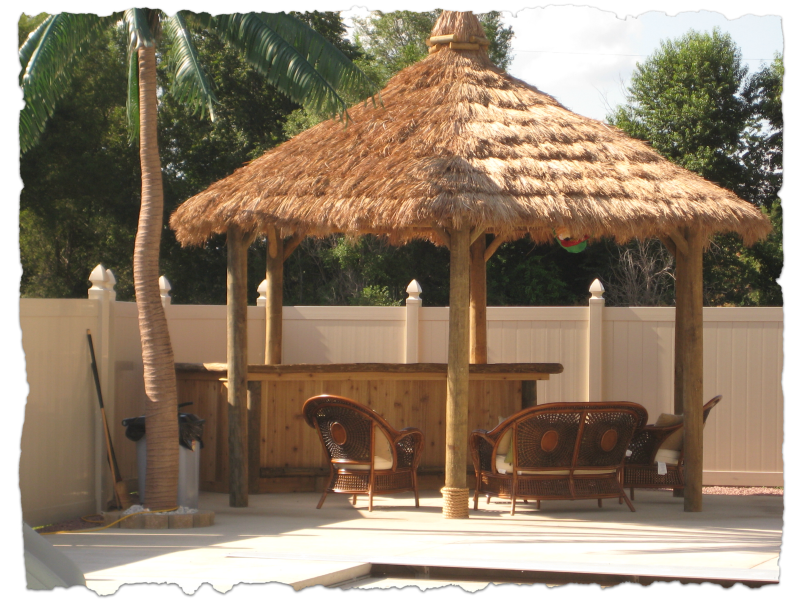
Tahiti Thatch is much thicker and more appropriate for waterproofing than Mexican Rain Cape.
This type of thatch is actually 98% water-proof. Its thickness is what allows water drops to roll off of the roof and not soak through. The Tahiti thatch fronds are sewn with nylon rope for extra durability and offer an average of 6-7 years of life
Here’s a bit more information about Tahiti Thatch in this helpful video:
Thatch Reed Panels
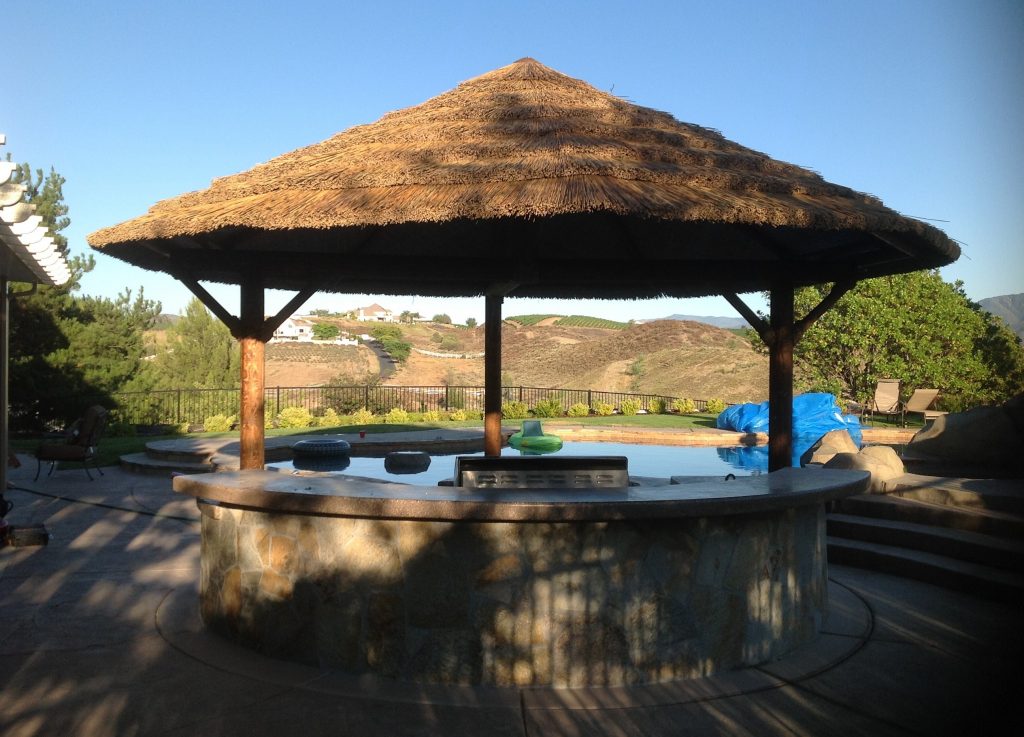
Thatch Reed Panels have a more refined classic look which makes them extremely popular for homeowners. They are made from natural African reeds which is the most durable and waterproof material on the market.
Finally, we answer whether you need a building permit in order to build a Tiki Hut…
Tiki Accessories (Signage, Accents, etc.)
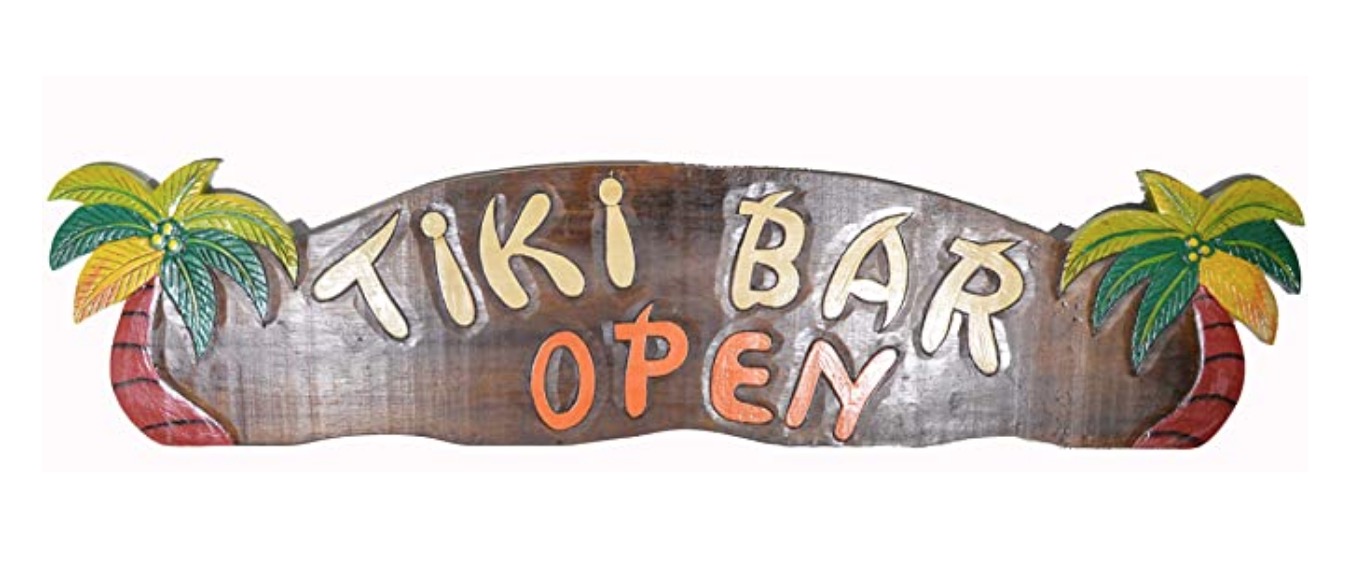
One thing that you’ll notice about a lot of tiki bars, if you happen to see them often enough, is that there are always lots of cool signs and accessories that go along with the tiki structure itself. Because tiki huts and bars are such a warm, welcoming place, the idea of signage is very much in line with the whole vibe of tiki huts. You’ll see these types of signs at cottages you visit too, with messages that welcome you in and have the feeling of home.
When it comes to tiki signs, we think that if they are made of actual wood, and hand-crafted, that is always a plus, but the beauty of having your own tiki hut is you can keep it simple, or be very elaborate. Whether you want to spend a lot of money or not much, it’s all about what fits your tiki vibe!
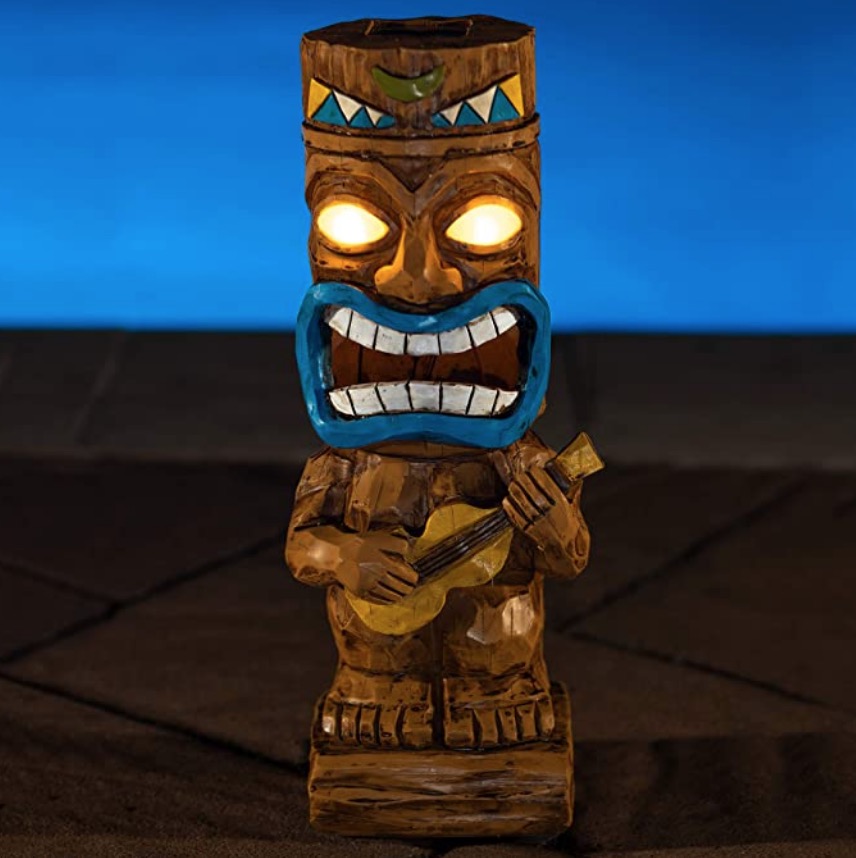
In addition to signs, you can also pick up little knick knacks, including statues, side tables, or other decorations that will make your tiki area more your own.
We love these little tiki men – especially this guy who is strumming a ukulele. Tikis also have a strong resonance with tropical music and things of that nature. The more fun you can infuse into your tiki set-up, the better!
Do You Need a Permit to Build a Tiki Hut?

Do you need to get Tiki Huts permits? Ultimately, this depends on the type of structure as well as local building codes.
Most states allow a tiki hut under a certain size to be built without a permit. In these states, you can build a tiki hut without building permit provided your hut doesn’t have plumbing, electrical or concrete features in the construction. However, you still have to abide by the local zoning laws.
Thanks for reading and please do share any comments or questions you have below!
Related posts:
- Tiki Hut Building Materials – An Overview
- Aloha! Where To Get The Best Tiki Sculptures – Our Favorite Shops
- TikiBarToGo – Why Portable Tiki Bars Are The Way To Go
- Sun Coast Tiki Huts – Tiki Gazebo Kits Custom Built For You
 |
 |
 |
 |

About William Murphy
William has worked as a general contractor in the city of Fremont, CA for over three decades. During that time, he's written articles about architecture, construction, and environmental protection for various publications. He is an expert on green building and sustainable design. When he's not writing or working, William enjoys spending time with his wife and two children.
Thoughts on "Outdoor Tiki Huts and Bars – A Basic Overview"
 |
 |
 |
 |
Backyard Stuff
You can Get FREE Gifts. Receive Free Backyard Items here. Disable Ad Blocker to get them all now!
Once done, hit anything below
 |
 |
 |
 |


